Study on the Factors Influencing the Separation of Sr and Nd in Sediments by Ion Exchange Resin
-
摘要: Sr和Nd同位素是地质学研究中经典的同位素定年和示踪体系。传统沉积物中Sr和Nd分离方法通常是利用AG50W-X8树脂分离Sr与稀土元素(REEs),再用Sr和Ln特效树脂分别对Sr和Nd纯化,但对于Fe元素含量较高的沉积物样品,该方法对REEs的洗脱率偏低,仅有50%。另外,AG50W-X8树脂高度、洗脱酸种类、Sr特效树脂淋洗酸体积以及Ln特效树脂过柱方式对Sr和Nd分离都有影响。为分析上述因素对Sr和Nd分离效果的影响,本文以水系沉积物标准物质GBW07309为例进行了研究,结果表明:①高含量的Fe会显著影响Sr和Nd的分离效果,而AG1-X8树脂可以有效去除Fe;②当AG50W-X8树脂高度为1 mL,硝酸作为洗脱酸时,Sr和REEs的分离效果较好;③Sr特效树脂淋洗酸中硝酸淋洗体积达到15 mL时可以有效分离Sr和Rb;④Ln特效树脂采用重力过柱方式时Sr和Nd分离效果较好,没有拖尾现象。本研究解决了Fe对分离Sr和Nd的干扰,K、Na、Ca、Mg、Fe、Rb、Sm去除率达到99%以上,完全满足Sr和Nd同位素分析的要求,为离子交换树脂法分离沉积物中Sr和Nd提供了较详细的前处理经验数据。Abstract:BACKGROUNDIn geological studies, Sr and Nd isotopes are classical isotopic dating and tracer systems.OBJECTIVESThe traditional separation method usually uses the AG50W-X8 resin to elute and separate Sr and REEs in sediments, and then uses Sr-special resin and Ln-special resin to purify Sr and Nd, respectively. However, this method has lower recovery of REEs (only 50%) for sediments with high Fe content.METHODSIn addition, height and elution acid species of AG50W-X8 resin, Sr resin elution acid volume, and Ln resin washing ways have impacts on the separation of Sr and Nd. In this work, in order to investigate the effect of these factors on the separation of Sr and Nd in detail, we took river sediment (GBW07309) as an example.RESULTSThe results showed that (1) high Fe content significantly affected the separation effect of Sr and Nd, and AG1-X8 resin could effectively remove Fe; (2) using 1 mL AG50W-X8 resin and HNO3 as the eluting acid, the separation effect of Sr and REEs was the best; (3) Sr and Rb could be effectively separated when the elution acid volume of Sr-special resin reaches 15 mL; (4) Nd was separated well without trailing phenomenon when gravity column method was used to wash the Ln-special resin.CONCLUSIONSThis method solves the Fe interference during separation of Sr and Nd. More than 99% of K, Na, Ca, Mg, Fe, Rb, and Sm were removed, which fully satisfied the requirements for the analysis of Sr and Nd isotopes. This paper provides more detailed empirical data for the separation of Sr and Nd isotopes in sediments by ion exchange resin method.
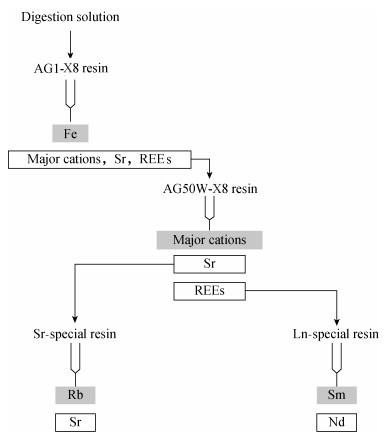
-
Keywords:
- sediments /
- Sr /
- Nd /
- ion exchange resins /
- Fe /
- rare earth elements
-
地质学研究中沉积物Sr和Nd同位素体系属于传统的同位素地球化学研究对象,是经典的同位素定年和示踪体系,被广泛应用于岩石成因与地幔演化[1-2]、岩石风化[3]、古海洋和古气候[4-5]、沉积物物源示踪[6-9]等研究中,因此准确测定沉积物中Sr和Nd的同位素比值具有重要的地球化学意义。沉积物中的Sr(87Sr/86Sr)和Nd(εNd值)同位素组成常被用来识别和表征沉积物来源。如Sr和Nd同位素数据确立了恒河河流系统的运移方式[10],为中国东海确立了三个端元,对东部陆架区沉积物“源-汇”过程及陆海相互作用提供了科学依据[11],另外Sr和Nd同位素分析还说明了岩浆的组成,这对于东北亚大陆边缘的构成起到了重要作用[12]。但沉积物中Sr和Nd含量相对偏低,Sr大约20~900 μg/g,Nd大约10~30 μg/g,且样品基质复杂,SiO2含量大约60%~80%,Al2O3大约12%~19%,Fe2O3大约1%~8%,K2O大约1%~6%[12],使得预分离成为Sr和Nd同位素分析中的必需步骤。常规方法大多是利用AG50W-X8阳离子交换树脂分离沉积物中Sr和稀土元素(REEs),再用Sr特效树脂和Ln特效树脂分别进行Sr和Nd的分离纯化[13-16]。据文献报道,该方法对于Fe含量高的地质样品,REEs的洗脱率偏低(50%)[17-18],因此如何有效去除Fe元素是分离沉积物中Sr和REEs的关键。文献报道了AG1-X8树脂是大孔径强碱性阴离子交换树脂,碱金属和碱土金属阳离子通过交换柱时,因以阳离子形式存在不被吸附,随淋洗液淋洗出来,而Cu、Fe、Zn在高浓度盐酸中形成络阴离子,可以通过盐酸洗脱下来[18],表明了AG1-X8树脂可以用来去除Fe元素的可行性。
离子交换树脂法是根据不同组分离子对固定离子基团的亲和力的差别而达到分离的目的,因而不同的酸介质、不同的酸浓度都会影响离子的洗脱顺序[19],而且树脂床高度的不同也会影响树脂柱有效踏板数,影响离子在树脂中的保留时间,继而对离子分离效率产生影响[20-21]。此外,离子交换树脂不同的淋洗酸体积会明显影响干扰离子的去除率和目标离子的洗脱率[22],而且不同的洗脱速度也会明显影响洗脱率。当树脂流动相采用较低的流速时,一般峰高较高,分离度也较大,但流速低,洗脱时间延长,又会降低单位树脂的生产能力,而过快的流速则会将阳离子交换树脂表面的有机基团冲刷移动[21-22],因此找到合适的分离条件是离子交换树脂分离法的关键。本文以水系沉积物标准物质(GBW07309)为例,主要探讨高浓度的Fe以及AG50W-X8树脂柱高度和洗脱酸种类、Sr特效树脂淋洗酸体积以及Ln特效树脂不同过柱方式对Sr和Nd分离效果的影响,优化了采用离子交换树脂法分离沉积物中Sr和Nd的前处理条件,为Sr和Nd同位素分析提供了可靠数据基础。
1. 实验部分
1.1 仪器与工作条件
ICAP-Q型电感耦合等离子体质谱仪(ICP-MS,美国ThermoFisher公司),ICAP-6300型电感耦合等离子体发射光谱仪(ICP-OES,美国ThermoFisher公司),仪器工作条件列于表 1。
表 1 ICP-MS和ICP-OES仪器工作条件Table 1. Measurement conditions of the ICP-MS and ICP-OESICP-MS ICP-OES 工作参数 设定条件 工作参数 设定条件 等离子体功率 1548 W 射频功率 1150 W 雾化气流量 1.057 L/min 最大积分时间 30 s 冷却气流量 13.82 L/min 辅助气(Ar)流量 0.5 L/min 辅助气流量 0.79 L/min 冲洗泵速 25 r/min 泵速 40.0 r/min 分析泵速 25 r/min 样品间隔冲洗时间 60 s 垂直观测高度 12 mm 测量模式 KED 样品冲洗时间 30 mm 蠕动泵(MP-2100,日本EYEL4公司),精密电子天平(MSE225P-000-DU,德国Sartorius公司)。
实验在1000级洁净实验室内完成。
1.2 标准与材料
GBW07309水系沉积物成分分析标准物质(购自国家标准物质研究中心):其中Sr含量166±14 μg/g,Nd含量34±3 μg/g,有机质含量低,符合沉积物性质,对于沉积物中Sr和Nd同位素分离具有可靠的参考价值。
稀土混合标准溶液和K、Na、Ca、Mg、Fe、Sr、Rb各单元素标准储备溶液(购自美国Inorganic Ventures公司):浓度均为1000 μg/mL,介质均为2%的硝酸。
AG50W-X8阳离子交换树脂(100~200目,美国Bio-Rad Laboratories公司)。AG1-X8阴离子交换树脂(100~200目,美国Bio-Rad Laboratories公司)。Sr特效树脂:Sr-Spec树脂(100~150 μm粒径,美国Eichrom Technologies公司)。Ln特效树脂:LN-C50-A树脂(粒径100~150 μm,美国Eichrom Technologies公司)。
离子交换柱:①去Fe柱:内径为7 mm的聚丙烯材质的交换柱,内装AG1-X8阴离子交换树脂,树脂床水中高度2 mL。②Sr和REEs分离柱:内径为7 mm的聚丙烯材质的交换柱,内装AG50W-X8阳离子交换树脂,树脂床水中高度1 mL。③Rb和Sr分离柱:内径为7 mm的聚丙烯材质的交换柱,内装Sr特效树脂,树脂床水中高度2 mL。④Sm和Nd分离柱:内径为7 mm的聚丙烯材质的交换柱,内装Ln特效树脂,树脂床水中高度2 mL。
硝酸(痕量金属级,美国ThermoFisher公司);盐酸(痕量金属级,德国Merck公司);氢氟酸(优级纯,中国国药集团化学试剂有限公司)。
1.3 样品处理和锶钕分离方法
1.3.1 颗粒物消解
称取标准物质GBW07309(≤30 mg)于30 mL聚四氟乙烯消解罐中,加入硝酸-氢氟酸(体积比3:1),密闭,在平板加热板上180℃消解24 h,然后加入盐酸于120℃赶酸3次[23],得消解液,备用。
1.3.2 锶钕分步分离流程
(1) AG1-X8阴离子交换树脂去除消解液中的Fe元素:将消解液溶于1 mL 6 mol/L盐酸中,通过AG1-X8阴离子交换树脂,以6 mol/L盐酸淋洗分离Fe。
(2) AG50W-X8阳离子交换树脂去除其他主要阳离子,分离Sr和REEs:将样品溶解于1 mL 1 mol/L盐酸中,用2 mol/L硝酸、6 mol/L硝酸分别作为Sr和REEs的洗脱酸分离Sr和REEs[16]。
(3) Sr特效树脂分离纯化Sr:样品用1 mL 8 mol/L硝酸溶解,再用0.05 mol/L硝酸洗脱分离Rb和Sr。
(4) Ln特效树脂分离纯化Nd:将样品溶解于1 mL 1 mol/L盐酸中,再用0.25 mol/L盐酸洗脱分离Sm和Nd。
2. 结果与讨论
2.1 AG1-X8树脂去除Fe的效果
研究表明Sr和Nd样品的纯度会影响热电离质谱法的离子化效率,样品不纯会严重抑制信号强度和造成不稳定的离子束,其中Sr和Nd的离子化效率主要受到Ba、Fe、Ca的影响[24]。此外,本课题组在前期实验中还发现如果不先去除Fe元素,在后续Ln特效树脂分离REEs中的Nd实验中,蒸干样品无法完全溶解,影响元素洗脱效率,因此在沉积物Sr和Nd同位素分析前, 预先除去Ba、Fe、Ca尤其是Fe元素的影响意义重大。
本课题组首先尝试了利用常规分析方法中的AG50W-X8树脂对Fe和Sr、Nd的分离效果。如图 1a所示,Sr和REEs的洗脱曲线与Fe的洗脱曲线混在一起,难以分开,因此AG50W-X8树脂并不能将Fe与Sr和Nd完全分离。而文献[18, 24-25]报道了利用AG1-X8树脂能实现碱金属和碱土金属Na、K、Mg、Ca与过渡金属Cu、Fe、Zn的分离。为此本课题组继续尝试采用AG1-X8树脂单独分离Fe。将洗脱液每1 mL单独接样,然后测定元素浓度,根据体积计算元素含量。图 1b为AG1-X8树脂在6 mol/L盐酸介质中的洗脱曲线,可以看出在Sr元素的洗脱峰处,Fe元素的含量仅为0.30~0.35 ng/g。此结果表明所需元素Sr、REEs可以在1~3 mL完全洗脱出来。如表 2所示Fe的去除率达99%以上,Sr洗脱率在96%以上,符合后续实验需要。相比于Li等[24]单独使用AG50W-X8树脂分离Sr和REEs,本实验可以高效地去除Fe,而且不影响Sr和REEs洗脱率,也证实了Abbott等[16]利用AG1-X8树脂对地质样品去除Fe元素的能力。
表 2 AG1-X8树脂洗脱各元素的效率Table 2. Eluting efficiency of elements separated by AG1-X8 resin元素 洗脱率(%) 23Na 97.53 24Mg 97.52 39K 97.40 44Ca 96.67 57Fe 0.374 85Rb 96.42 88Sr 96.43 146Nd 98.59 147Sm 95.87 注:洗脱率= $ \frac{{\rm{洗脱液元素含量}}}{{\rm{样品上柱前元素含量}}}$ ×100%。Fe元素首先富集在树脂柱上,用盐酸洗脱目标元素,此时Fe被淋洗的效率是0.374%,而后再用硝酸单独洗脱Fe,效率在99.63%。2.2 AG50W-X8树脂高度和洗脱酸种类对锶、稀土元素分离的效果
AG50W-X8阳离子交换树脂为磺化聚苯乙烯,其在硝酸的梯度淋洗条件下,不仅能有效地分离基质元素如Na、Mg、Ca、K、Ba、Sr、Rb等,实现与REEs的分离,还能消除Ba所形成的多原子离子在质量数146附近对Nd元素质谱重叠干扰[18, 26-27]。研究表明树脂装填高度、树脂洗脱酸度等实验条件对元素分离的影响不可忽视[20-21],因此本文以Sr为例考察了AG50W-X8不同树脂高度、不同洗脱酸条件下的洗脱效果。如图 2所示,当树脂高度为2 mL时,使用硝酸为洗脱酸比以盐酸为洗脱酸的Sr洗脱峰更早出现,但峰高较低,回收率低;当树脂高度为1 mL,用硝酸作为洗脱酸时,洗脱峰高明显,在4 mL时就出现峰值,所以本实验采取树脂高度为1 mL的AG50W-X8树脂,以硝酸作为洗脱酸。
接着采用上述分离条件对标准物质进行实验,Sr的洗脱曲线如图 3a所示,10 mL 2 mol/L硝酸可以完全把Sr元素洗脱出来,峰值出现在4 mL,而K、Na、Ca、Mg、Rb、Sr洗脱率达到99%~100%。此外,从图 3a还可以看出K、Na、Mg、Rb在1~4 mL淋洗出来并混在了Sr洗脱液中,其中Ca与Sr洗脱曲线混合在一起,难以分开,因而需要后续Sr特效树脂再次分离。
再采用上述条件继续分离洗脱标准物质中的REEs,洗脱曲线如图 3b所示,REEs峰值明显,REEs元素需要10 mL 6 mol/L硝酸可以完全洗脱出来。Sr与Nd在1 mL AG50W-X8树脂以2 mol/L硝酸和6 mol/L硝酸依次为洗脱酸可以完全分离。相比于耿予欢等[21]增加树脂床高度来提高洗脱率,本研究结果表明降低AG50W-X8树脂高度会提高洗脱率,同时证实了汪齐连[19]指出改变树脂淋洗介质可以改变离子洗脱效率的结论,而且也表明用硝酸作为洗脱酸可以更好地洗脱分离Sr和REEs。
2.3 Sr特效树脂淋洗酸对锶纯化的效果
为解决AG50W-X8树脂洗脱Sr元素与K、Na、Ca、Mg、Rb等分离不彻底的问题,本实验进一步借助于Sr特效树脂纯化Sr。据文献报道,Sr特效树脂通常采用高浓度硝酸作为淋洗酸,低浓度硝酸作为洗脱酸[28-29]。本研究也采用了8 mol/L的高浓度硝酸作为淋洗酸和0.05 mol/L的低浓度硝酸作为洗脱酸洗脱Sr,并考察了不同淋洗酸体积对Sr的分离效果。实验结果表明,当采用5 mL 8 mol/L硝酸作为淋洗酸,10 mL 0.05 mol/L硝酸作为洗脱酸时,Sr溶液中的Rb含量几乎为Sr含量的一半,Rb、Sr不能彻底分开,对Sr同位素比值测定产生干扰;当采用15 mL 8 mol/L硝酸作为淋洗酸,10 mL 0.05 mol/L硝酸作为洗脱酸时,发现Sr溶液中的Rb含量可忽略不计,Rb、Sr可以完全分开。
最终本实验采用15 mL 8 mol/L硝酸作为淋洗酸,对AG50W-X8树脂洗脱Sr样品进行纯化。图 4为Sr特效树脂洗脱Sr曲线,可以明显看出Sr与其他基质离子完全分离,解决了AG50W-X8树脂不能很好地分离纯化Sr元素的问题,其中K、Na、Ca、Mg、Rb被1~10 mL 8 mol/L硝酸淋洗出来,Sr被1~10 mL 0.05 mol/L硝酸洗脱出来,K、Ca、Mg、Rb去除率达到99%以上,Rb/Sr=0.0088,满足Sr同位素测定要求。Horwitz等[28]、吴连生等[22]、唐索寒等[30]通过改变洗脱酸浓度可以实现Sr的有效分离,本文也证实了8 mol/L硝酸可以淋洗去除包括Fe、Na、Ca等大部分基质离子,0.05 mol/L硝酸可以完全洗脱Sr,另外吴连生等[22]还对Sr特效树脂淋洗酸体积作了相关研究,表明淋洗酸体积达到5~10 mL时对Sr洗脱的影响小,本研究则表明可以适当增加淋洗酸体积来提高Sr洗脱率。
2.4 Ln特效树脂洗脱方式对钕分离纯化的效果
Ln特效树脂为二(2-乙基己基)丙烯酸酯聚合物涂覆的非离子型丙烯酸酯聚合物,该树脂通过盐酸的洗脱,可以很好地分离REEs中的La、Ce、Pr、Nd、Sm、Eu等元素。已有研究表明,REEs元素加载到Ln特效树脂上,用0.25 mol/L盐酸洗脱,样品溶液装载到0.5 mL的0.25 mol/L盐酸中,可以有效地去除树脂中的大部分阳离子和其他轻稀土元素LREEs(如La、Ce、Pr),分离出Nd元素[31-32]。此外,文献报道了离子交换树脂采用不同的洗脱方式对流动相流速的影响也会明显改变洗脱效率,因此选用合适的洗脱方式可以有效提高洗脱率[21-22]。
本课题组对Ln特效树脂以10 mL 0.25 mol/L盐酸作为洗脱酸,对洗脱方式做了相关的条件实验。从图 5a可以看出采用蠕动泵过柱,会有少许拖尾,需要加大洗脱酸体积,而采用重力过柱用10 mL盐酸可以有效分离Sm、Nd,因此本文采用重力过柱从REEs中分离Nd。图 5b为Ln特效树脂洗脱Nd曲线,可以看出12 mL 0.25 mol/L盐酸可以实现Sm与Nd的完全分离,峰值明显,经计算Sm去除率达99%以上,Sm/Nd=0.0083,已经达到了同位素测定要求。Huang等[31]、Pin等[32]通过改变Ln特效树脂洗脱酸介质浓度来分离Nd,本实验证实了可以通过0.25 mol/L盐酸有效分离纯化Nd。另外,吴连生等[22]发现洗脱树脂流速对分离效果也有明显影响,本实验通过不同过柱方式来改变流速,发现采用重力自然过柱可以更好地分离Nd,洗脱曲线没有拖尾现象。
3. 结论
本文通过离子交换树脂法对沉积物中Sr和Nd元素分离的影响因素进行了研究,发现AG1-X8树脂可以有效去除Fe的干扰;同时,当分离条件为AG50W-X8树脂高度1 mL、洗脱酸为硝酸、Sr特效树脂淋洗酸体积15 mL、Ln特效树脂采用重力过柱方式时,Sr和Nd的分离效果最好。该方法不仅解决了Fe对分离Sr和Nd的干扰问题,而且K、Na、Ca、Mg、Fe、Rb、Sm等基质的去除率达到99%以上,完全满足后续Sr和Nd同位素分析的要求,为离子交换树脂法分离沉积物中Sr和Nd同位素提供了较详细的前处理经验数据,也可为其他地质样品中Sr和Nd同位素比值分析奠定基础。
-
表 1 ICP-MS和ICP-OES仪器工作条件
Table 1 Measurement conditions of the ICP-MS and ICP-OES
ICP-MS ICP-OES 工作参数 设定条件 工作参数 设定条件 等离子体功率 1548 W 射频功率 1150 W 雾化气流量 1.057 L/min 最大积分时间 30 s 冷却气流量 13.82 L/min 辅助气(Ar)流量 0.5 L/min 辅助气流量 0.79 L/min 冲洗泵速 25 r/min 泵速 40.0 r/min 分析泵速 25 r/min 样品间隔冲洗时间 60 s 垂直观测高度 12 mm 测量模式 KED 样品冲洗时间 30 mm 表 2 AG1-X8树脂洗脱各元素的效率
Table 2 Eluting efficiency of elements separated by AG1-X8 resin
元素 洗脱率(%) 23Na 97.53 24Mg 97.52 39K 97.40 44Ca 96.67 57Fe 0.374 85Rb 96.42 88Sr 96.43 146Nd 98.59 147Sm 95.87 注:洗脱率= $ \frac{{\rm{洗脱液元素含量}}}{{\rm{样品上柱前元素含量}}}$ ×100%。Fe元素首先富集在树脂柱上,用盐酸洗脱目标元素,此时Fe被淋洗的效率是0.374%,而后再用硝酸单独洗脱Fe,效率在99.63%。 -
朱炳泉.从壳幔同位素体系看不同地体的化学不均一性[J].科学通报, 1990, 35(21):1653-1655. http://kns.cnki.net/KCMS/detail/detail.aspx?filename=KXTB199021015&dbname=CJFD&dbcode=CJFQ Zhu B Q.Study on chemical heterogeneity of different terrane from slow shell isotope system[J].Chinese Science Bulletin, 1990, 35(21):1653-1655. http://kns.cnki.net/KCMS/detail/detail.aspx?filename=KXTB199021015&dbname=CJFD&dbcode=CJFQ
何连花, 张俊, 高晶晶, 等.地质样品Sr和Nd同位素的化学分离方法改进[J].海洋科学进展, 2014, 32(1):78-83. doi: 10.3969/j.issn.1671-6647.2014.01.009 He L H, Zhang J, Gao J J, et al.Improvement of the method for chemical separations of Sr and Nd in geological samples[J].Advances in Marine Science, 2014, 32(1):78-83. doi: 10.3969/j.issn.1671-6647.2014.01.009
张永清, 凌文黎, 李方林.峡东地区南华纪-寒武纪地层风化过程元素及Sr-Nd同位素演化特征及其地球化学意义[J].地球科学, 2008, 33(3):301-312. http://d.old.wanfangdata.com.cn/Periodical/dqkx200803002 Zhang Y Q, Ling W L, Li F L.Element and Sr-Nd isotopic mobility during weathering process of the Nanhuaian-Cambrian sedimentary strata in the Eastern Three Gorges and its geochemical implication[J].Earth Science, 2008, 33(3):301-312. http://d.old.wanfangdata.com.cn/Periodical/dqkx200803002
Blaser P, Lippold J, Gutjahr M, et al.Extracting foramini-feral seawater Nd isotope signatures from bulk deep sea sediment by chemical leaching[J].Chemical Geology, 2016, 439:189-204. doi: 10.1016/j.chemgeo.2016.06.024
Dera G, Prunier J, Smith P L, et al.Nd isotope constraints on ocean circulation, paleoclimate, and continental drainage during the Jurassic breakup of Pangea[J].Gondwana Research, 2015, 27(4):1599-1615. doi: 10.1016/j.gr.2014.02.006
杨守业, 蒋少涌, 凌洪飞, 等.长江河流沉积物Sr-Nd同位素组成与物源示踪[J].中国科学(地球科学), 2007, 37(5):682-690. http://d.old.wanfangdata.com.cn/Periodical/zgkx-cd200705013 Yang S Y, Jiang S Y, Ling H F, et al.Sr-Nd isotopic composition and source tracing of sediments from the Yangtze River[J].Science China (Earth Science), 2007, 37(5):682-690. http://d.old.wanfangdata.com.cn/Periodical/zgkx-cd200705013
邵磊, 李长安, 张玉芬, 等.长江上游水系沉积物锶-钕同位素组成及物源示踪[J].沉积学报, 2014, 32(2):290-295. http://kns.cnki.net/KCMS/detail/detail.aspx?filename=CJXB201402013&dbname=CJFD&dbcode=CJFQ Shao L, Li C A, Zhang Y F, et al.Sr-Nd isotopic compositions of the upper Yangtze River sediments:Implications for tracing sediment sources[J].Acta Sedimentologica Sinica, 2014, 32(2):290-295. http://kns.cnki.net/KCMS/detail/detail.aspx?filename=CJXB201402013&dbname=CJFD&dbcode=CJFQ
Clift P D, Blusztajn J, Duc N A.Large-scale drainage capture and surface uplift in Eastern Tibet-SW China before 24Ma inferred from sediments of the Hanoi Basin, Vietnam[J].Geophysical Research Letters, 2006, 33(19):1-4. http://www.wanfangdata.com.cn/details/detail.do?_type=perio&id=JJ023706853
Clift P D, Long H V, Hinton R, et al.Evolving East Asian river systems reconstructed by trace element and Pb and Nd isotope variations in modern and ancient Red River-Song Hong sediments[J].Geochemistry Geophysics Geosystems, 2013, 9(4):1-29. doi: 10.1029-2007GC001867/
Awasthi N, Ray E, Paul D.Sr and Nd isotope compo-sitions of alluvial sediments from the Ganga Basin and their use as potential proxies for source identification and apportionment[J].Chemical Geology, 2018, 476:327-339. doi: 10.1016/j.chemgeo.2017.11.029
密蓓蓓, 刘升发, 窦衍光, 等.东海周边中小型河流沉积物锶钕铅同位素组成及其物源示踪意义[J].海洋通报, 2017, 36(4):440-448. http://d.old.wanfangdata.com.cn/Periodical/hytb201704011 Mi B B, Liu S F, Dou Y G, et al.Sr-Nd-Pb isotopic compositions in the sediments of the middle and small rivers around the East China Sea and the implications for tracing sediment sources[J].Marine Science Bulletin, 2017, 36(4):440-448. http://d.old.wanfangdata.com.cn/Periodical/hytb201704011
Zhao P, Jahn B M, Xu B.Elemental and Sr-Nd isotopic geochemistry of Cretaceous to Early Paleogene granites and volcanic rocks in the Sikhote-Alin Orogenic Belt (Russian Far East) and their implication on regional tectonic evolution[J].Journal of Asian Earth Sciences, 2017, 146:383-401. doi: 10.1016/j.jseaes.2017.06.017
刘文刚, 刘卉, 李国占, 等.离子交换树脂在地质样品Sr-Nd同位素测定中的应用[J].地质学报, 2017, 91(11):2584-2592. doi: 10.3969/j.issn.0001-5717.2017.11.013 Liu W G, Liu H, Li G Z, et al.The application of ion exchange resins in Sr-Nd isotopic assay of geological samples[J].Acta Geologica Sinica, 2017, 91(11):2584-2592. doi: 10.3969/j.issn.0001-5717.2017.11.013
黄成敏, 王成善.风化成土过程中稀土元素地球化学特征[J].稀土, 2002, 23(5):46-49. doi: 10.3969/j.issn.1004-0277.2002.05.013 Huang C M, Wang C S.Geochemical features of rare earth elements in process of rock weathering and soil formation[J].Chinese Rare Earths, 2002, 23(5):46-49. doi: 10.3969/j.issn.1004-0277.2002.05.013
陈天宇. 中北太平洋深水放射成因钕-铅-铪同位素物源与演化[D]. 南京: 南京大学, 2015. http://www.wanfangdata.com.cn/details/detail.do?_type=degree&id=Y2942074 Chen T Y. The Source and Evolution of Radiogenic Nd-Pb-Hf Isotopes in Central North Pacific Deep Water[D]. Nanjing: Nanjing University, 2015. http://www.wanfangdata.com.cn/details/detail.do?_type=degree&id=Y2942074
Abbott A N, Haley B A, Mcmanus J.The impact of sedi-mentary coatings on the diagenetic Nd flux[J].Earth & Planetary Science Letters, 2016, 449:217-227. http://www.sciencedirect.com/science/article/pii/S0012821X16302886
Iwasaki K, Haraguchi H, 刘然.ICP/AES法测定地质样品中的稀土元素——草酸盐沉淀和离子交换分离[J].世界核地质科学, 1991(1):90-94. http://www.wanfangdata.com.cn/details/detail.do?_type=perio&id=QK000000858320 Iwasaki K, Haraguchi H, Liu R.Determination of rare earth elements in geological samples by ICP/AES-Sedimentation and ion exchange separation of oxalate[J].World Nuclear Geoscience, 1991(1):90-94. http://www.wanfangdata.com.cn/details/detail.do?_type=perio&id=QK000000858320
孙剑, 朱祥坤, 唐索寒, 等. AGMP-1阴离子交换树脂元素分离方法再研究[C]//全国成矿理论与找矿方法学术讨论会论文集, 2009. http://kns.cnki.net/KCMS/detail/detail.aspx?filename=KWXB2009S1317&dbname=CJFD&dbcode=CJFQ Sun J, Zhu X K, Tang S H, et al. Further Investigation on Elemental Separation Using AGMP-1 Anion Exchange Resin[C]//Proceedings of National Seminar of Metallogenic Theory and Prospecting Methods, 2009. http://kns.cnki.net/KCMS/detail/detail.aspx?filename=KWXB2009S1317&dbname=CJFD&dbcode=CJFQ
汪齐连. 运用MC-ICP-MS测定天然样品的锂同位素组成[D]. 贵阳: 中国科学院研究生院(地球化学研究所), 2006. http://www.irgrid.ac.cn/handle/1471x/178973 Wang Q L. Measurement of Lithium Isotope in Natural Samples Using MC-ICP-MS[D]. Guiyang: Graduate School of the Chinese Academy of Sciences (Institute of Geochemistry), 2006. http://www.irgrid.ac.cn/handle/1471x/178973
王帮臣, 刘明言. 大孔吸附树脂颗粒液-固流化床分离银杏黄酮的研究[C]//中国颗粒学会学术年会暨海峡两岸颗粒技术研讨会论文集, 2008. http://cpfd.cnki.com.cn/Article/CPFDTOTAL-ZGKL200812002077.htm Wang B C, Liu M Y. Macroporous Resin Adsorption of Ginkgo Flavonoid in Liquid-Solid Fluidized Beds[C]//Proceedings of Conference of Chinese Society of Particuology & Symposium on Particle Technology across Taiwan Straits, 2008. http://cpfd.cnki.com.cn/Article/CPFDTOTAL-ZGKL200812002077.htm
耿予欢, 张本山, 高大维, 等.强酸性阳离子交换树脂分离纯化异麦芽低聚糖的研究[J].食品科学, 1999, 20(5):6-8. doi: 10.3321/j.issn:1002-6630.1999.05.002 Geng Y H, Zhang B S, Gao D W, et al.Separation and purification of isomalt oligosaccharides by strong acid cation exchange resin[J].Food Science, 1999, 20(5):6-8. doi: 10.3321/j.issn:1002-6630.1999.05.002
吴连生, 曾帆, 王萦, 等.锶特效树脂用于环境水样品中90Sr的富集、分离和测量方法研究[J].核化学与放射化学, 2015, 37(6):476-483. http://d.old.wanfangdata.com.cn/Periodical/hhxyfshx201506015 Wu L S, Zeng F, Wang Y, et al.Application of Sr specific resin on enrichment, separation and determination of 90Sr in environmental water[J].Journal of Nuclear and Radiochemistry, 2015, 37(6):476-483. http://d.old.wanfangdata.com.cn/Periodical/hhxyfshx201506015
张保科, 温宏利, 王蕾, 等.封闭压力酸溶-盐酸提取-电感耦合等离子体质谱法测定地质样品中的多元素[J].岩矿测试, 2011, 30(6):737-744. doi: 10.3969/j.issn.0254-5357.2011.06.016 Zhang B K, Wen H L, Wang L, et al.Quantification of multi-elements in geological samples by inductively coupled plasma-mass spectrometry with pressurized decomposition-hydrochloric acid extraction[J].Rock and Mineral Analysis, 2011, 30(6):737-744. doi: 10.3969/j.issn.0254-5357.2011.06.016
Li C F, Li X H, Li Q L, et al.Rapid and precise deter-mination of Sr and Nd isotopic ratios in geological samples from the same filament loading by thermal ionization mass spectrometry employing a single-step separation scheme[J].Analytica Chimica Acta, 2012, 727(10):54-60. http://www.sciencedirect.com/science/article/pii/S0003267012004576
Maréchal C N, Télouk P, Albarède F.Precise analysis of copper and zinc isotopic compositions by plasma-source mass spectrometry[J].Chemical Geology, 1999, 156(1-4):251-273. doi: 10.1016/S0009-2541(98)00191-0
曹心德, 尹明, 王晓蓉.AG50W-x8树脂分离去除钡的多原子离子对电感耦合等离子体质谱法测定稀土元素的质谱干扰[J].分析化学, 2001, 29(8):890-893. doi: 10.3321/j.issn:0253-3820.2001.08.005 Cao X D, Yin M, Wang X R.Elimination of the spectral interference from barium polyatomic ions on rare earth elements in inductively coupled plasma mass spectrometry by AG50W-x8 cation exchange chromato-graphic separation[J].Chinese Journal of Analytical Chemistry, 2001, 29(8):890-893. doi: 10.3321/j.issn:0253-3820.2001.08.005
李艳玲, 熊采华, 黄慧萍, 等.基体分离-电感耦合等离子体质谱测定重晶石中超痕量稀土元素[J].岩矿测试, 2005, 24(2):87-92. doi: 10.3969/j.issn.0254-5357.2005.02.002 Li Y L, Xiong C H, Huang H P, et al.Determination of ultra-trace rare earth elements in barite by ICP-MS after matrix separation[J].Rock and Mineral Analysis, 2005, 24(2):87-92. doi: 10.3969/j.issn.0254-5357.2005.02.002
Horwitz E P, Chiarizia R, Dietz M L.A novel strontium-selective extraction chromatographic resin[J].Solvent Extraction & Ion Exchange, 1992, 10(2):313-336. https://www.mendeley.com/research-papers/novel-strontiumselective-extraction-chromatographic-resin/
吴述超, 曹颁, 董利明, 等.锶特效树脂萃取-色谱耦合热电离同位素质谱法测定海水中锶同位素研究[J].中国无机分析化学, 2015, 5(1):15-18. doi: 10.3969/j.issn.2095-1035.2015.01.005 Wu S C, Cao B, Dong L M, et al.Determination of Sr isotopic ratio in seawater by extraction chromatographic separation-thermal ionization mass spectrometry coupled selective resin[J].Chinese Journal of Inorganic Analytical Chemistry, 2015, 5(1):15-18. doi: 10.3969/j.issn.2095-1035.2015.01.005
唐索寒, 朱祥坤, 李津, 等.利用锶特效树脂分离富集岩石样品中的锶及测定87Sr/86Sr[J].分析化学, 2010, 38(7):999-1002. http://www.wanfangdata.com.cn/details/detail.do?_type=perio&id=fxhx201007016 Tang S H, Zhu X K, Li J, et al.Separation and isotopic measurement of Sr in rock samples using selective specific resins[J].Chinese Journal of Analytical Chemistry, 2010, 38(7):999-1002. http://www.wanfangdata.com.cn/details/detail.do?_type=perio&id=fxhx201007016
Huang K F, Blusztajn J, Oppo D W, et al.High-precision and accurate determinations of neodymium isotopic compositions at nanogram levels in natural materials by MC-ICP-MS[J].Journal of Analytical Atomic Spectrometry, 2012, 27(9):1560-1567. doi: 10.1039/c2ja30123g
Pin C, Zalduegui J S.Sequential separation of light rare-earth elements, thorium and uranium by miniaturized extraction chromatography:Application to isotopic analyses of silicate rocks[J].Analytica Chimica Acta, 1997, 339(1-2):79-89. doi: 10.1016/S0003-2670(96)00499-0
-
期刊类型引用(12)
1. 庞鹤亮,丁江博,王岩,刘嘉伟,秦琪文,张瑞洋,徐兵,杜娟娟,张博,卢金锁. 排水管网通沟污泥组分分离技术研究进展. 环境工程. 2025(01): 89-96 .  百度学术
百度学术
2. 赵令浩,孙冬阳,胡明月,袁继海,范晨子,詹秀春. 激光剥蚀-扇形磁场电感耦合等离子体质谱法同时测定锆石U-Pb年龄和微量元素含量. 岩矿测试. 2024(01): 47-62 .  本站查看
本站查看
3. 王奇奇,孙贺,顾海欧,侯振辉,葛粲,汪方跃,周涛发. 磺酸型阳离子树脂的元素分配行为及高精度同位素分析应用. 岩矿测试. 2024(01): 63-75 .  本站查看
本站查看
4. 张会乔,张若煊,时燕华,李雪明,周林军,李雅琪. P204萃取和盐酸反萃取对土壤中钇的分离研究. 世界核地质科学. 2024(05): 1032-1039 .  百度学术
百度学术
5. 张会乔,张若煊,时燕华,李雪明,周林军. 土壤中放射性核素~(90)Sr测试中~(210)Bi干扰的修正研究. 世界核地质科学. 2024(06): 1253-1259 .  百度学术
百度学术
6. 骆正骅,李超,赖正,王晨羽,郭玉龙,段知非,徐娟,杨守业. 树脂柱串联法分离地质样品中Sr-Nd-U. 岩矿测试. 2023(01): 102-113 .  本站查看
本站查看
7. 张文杰,童雄,谢贤,封东霞,杜云鹏,宋强. 稀土分离纯化技术研究现状. 中国稀土学报. 2022(01): 24-37 .  百度学术
百度学术
8. 马秀凤,高鹏. ~(90)Sr分析方法的研究进展. 职业与健康. 2022(10): 1426-1431 .  百度学术
百度学术
9. 闻静,张羽旭,温汉捷,朱传威,樊海峰. 特殊地质样品中钼同位素分析的化学前处理方法研究. 岩矿测试. 2020(01): 30-40 .  本站查看
本站查看
10. 朱志勇,朱祥坤,杨涛. 自动分离提纯系统的研制及其在同位素分析测试中的应用. 岩矿测试. 2020(03): 384-390 .  本站查看
本站查看
11. 朱志勇,潘辰旭,朱祥坤. 利用套柱法快速分离提纯Sr和Nd元素. 岩矿测试. 2020(04): 515-524 .  本站查看
本站查看
12. 李贵彬. 探究废离子交换树脂的优化处理. 当代化工研究. 2019(01): 80-81 .  百度学术
百度学术
其他类型引用(10)



 下载:
下载:
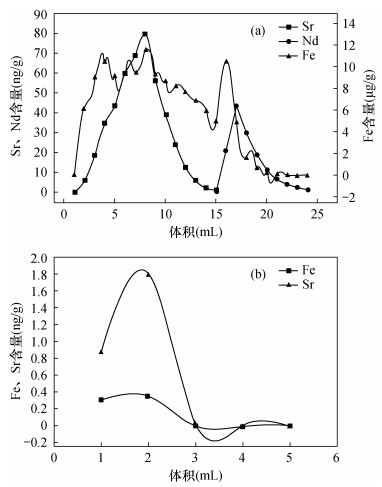
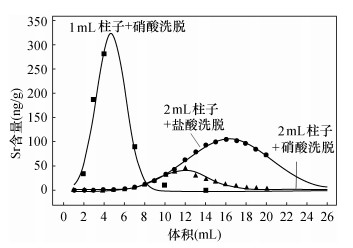
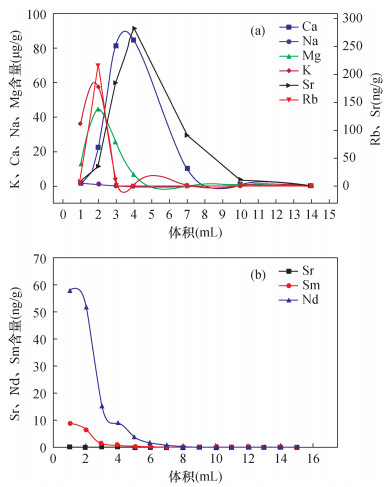
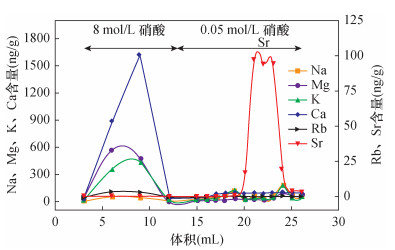
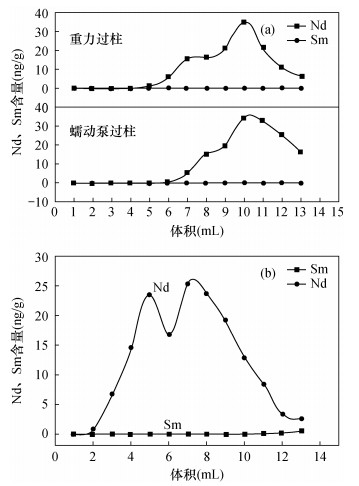
 京公网安备 11010202008159号
京公网安备 11010202008159号